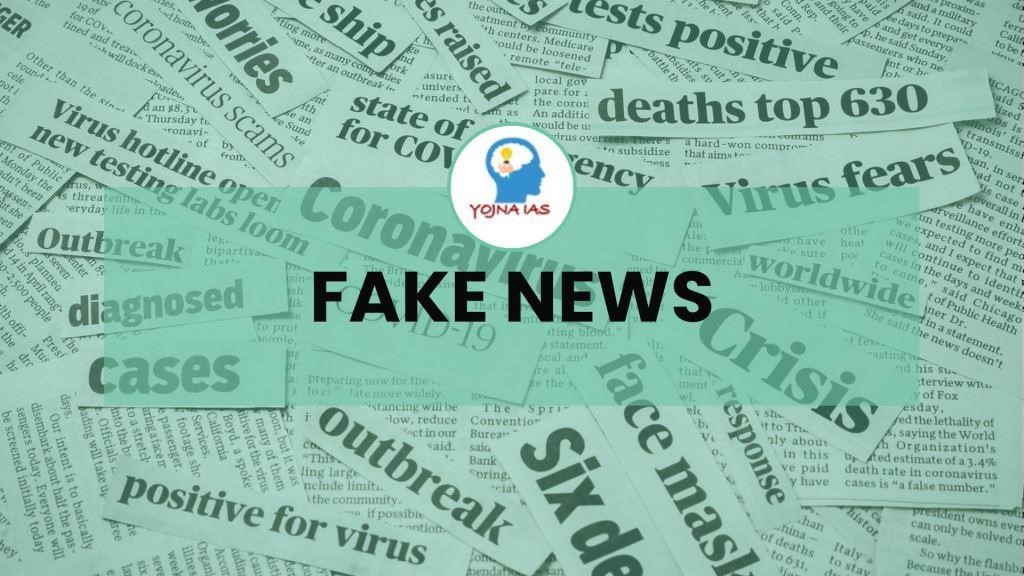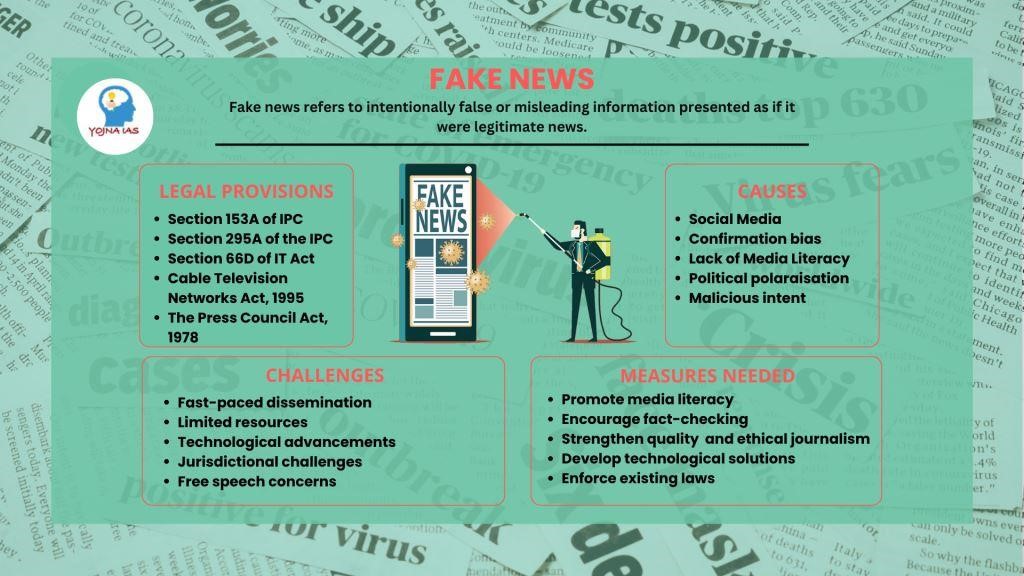07 Apr 2023 Fake News
Fake News
This article covers “Daily Current Affairs” and the topic details “Fake News”. The topic “Fake News” has relevance in the “Polity and Governance” section for the UPSC CSE exam.

Fake News
For Prelims:
- What is Fake News?
What are the provisions in Indian law to prevent the spread of Fake News?
For Mains:
GS 2: Polity and Governance
- Causes for the Spread of Fake News
- Challenges in Dealing with Fake News
- Measures to Stop the Spread of Fake News
Why in the news?
Recently the government has declared that fake news will be tagged by PIB and the platform hosting it must pull it down. The government has changed the IT laws and has made it clear that the hosting platforms will no longer enjoy legal immunity on content posted by their users; platforms can now be called a party in court proceedings.
What is Fake News?
Fake news refers to intentionally false or misleading information presented as if it were legitimate news. The rapid proliferation of social media has propelled the spread of fake news in India. The concept of Fake news is not new but what is worrying is the speed at which it can spread and create misinformation.

What is fake news
What are the provisions in Indian law to prevent the spread of Fake News?
In India, there are various provisions in the law to prevent the spread of fake news. Some of the key provisions are as follows:
- Section 153A of the Indian Penal Code (IPC): This provision makes it a criminal offense to promote enmity between different groups on grounds of religion, race, place of birth, residence, language, etc. by making or spreading false statements.
- Section 295A of the IPC: This provision criminalizes deliberate and malicious acts that are intended to outrage religious feelings.
- Section 66D of the Information Technology Act (IT Act): This provision makes it an offense to cheat someone through fraudulent or dishonest representation using a computer resource or communication device.
- The Cable Television Networks (Regulation) Act, 1995: This Act empowers the government to regulate cable television networks and take action against them for broadcasting objectionable content.
- The Press Council Act, 1978: This Act establishes the Press Council of India, which has the power to censure or admonish newspapers or news agencies for publishing fake news.
What are the causes of the spread of Fake News?
The spread of fake news is a complex phenomenon with multiple causes. The issue is the damage it can cause and the speed with which it can create a misinformation campaign. Here are some of the key factors that contribute to the spread of fake news:
- Exponential growth in the use of Social media: It is a double-edged sword. Social media platforms have made it easier than ever before to create and share content. However, this also means that fake news can spread rapidly and widely, often without being fact-checked.
- Confirmation bias: People tend to believe information that confirms their pre-existing beliefs, and this bias can make them more susceptible to fake news. For example, majoritarian ideas without any scientific validation are easily absorbed by people.
- Lack of media literacy: Many people lack the skills and knowledge to critically evaluate news sources and identify fake news. For example, any kind of information available on the internet is considered gospel truth.
- Political polarisation: In highly polarised societies, fake news can be used as a tool to manipulate public opinion and reinforce existing biases. For example, a lot of fake narratives are spread during the time of the election. By the time the information is verified the damage is already done.
- Malicious intent: Some individuals or groups intentionally spread fake news to sow discord, create chaos, or promote their own agenda.
What are the challenges in dealing with Fake News?
In order to deal with fake news it is important to take cognizance of certain of the challenges associated with it. They are as follows:
- Fast-paced dissemination: Fake news can spread rapidly through social media platforms and other online channels, making it difficult to contain and control its spread.
- Limited resources: Fact-checking and verifying fake news sources requires time, effort, and resources, which can be a challenge for many news organizations and individuals.
- Technological advancements: The use of deep fakes and other advanced technologies makes it increasingly difficult to distinguish between real and fake news. For example, the fake speeches of political leaders can manipulate election outcomes.
- Jurisdictional challenges: In some cases, it can be difficult to take legal action against those who spread fake news, particularly if they are located in another jurisdiction. Social media sites claim that they have no control over the content. They are only a medium and not the producer of information.
- Free speech concerns: There are concerns that efforts to combat fake news may infringe upon free speech rights, which can make it challenging to find effective solutions. The Minister of Information has clarified that this move should not be considered an attack on free speech but an attack on misinformation.
What are the measures to stop the spread of Fake News?
There are several measures that can be taken to stop the spread of fake news. Here are some of the key steps that individuals, organizations, and governments can take:
- Promote media literacy: Education and awareness campaigns can help individuals learn how to identify fake news, fact-check sources, and evaluate information critically. There is a need to educate people to be mindful of any kind of news they encounter
- Encourage fact-checking: News organizations and social media platforms can promote fact-checking of fake news by providing tools and resources that make it easier for people to verify the information. There is a need to fund organizations and individuals who are regularly engaged in fact-checking.
- Strengthen the quality and ethical journalism: High-quality journalism that adheres to ethical standards and fact-checking protocols can help to counter the spread of fake news. It has been seen at times that media houses run news without any verification. The apology and corrections are late.
- Develop technological solutions: AI-powered tools that can identify and flag fake news can help to limit its spread.
- Enforce existing laws: Governments can use existing legal provisions to take action against those who spread fake news, such as by imposing fines or penalties. There is a need to uphold the law objectively without conjuring political affiliations.
Yojna IAS daily current affairs eng med 7th April2023
Way Forward
Overall, stopping the spread of fake news will require a collaborative effort that involves individuals, organizations, and governments. By taking proactive steps as mentioned above we can work together to combat the spread of fake news and ensure that accurate information is widely available.
Sources:
Get Daily Current Affairs from Yojna IAS


No Comments